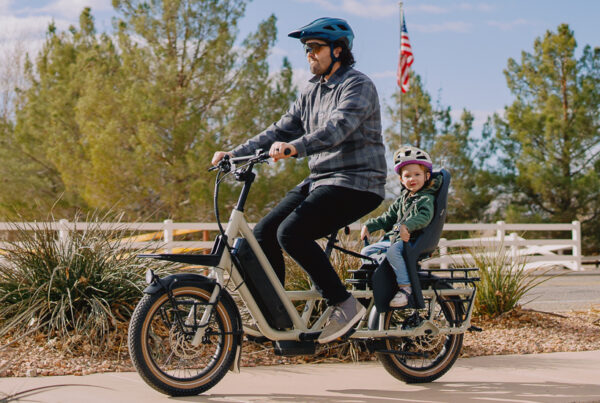Mistake #5: Being Unrealistic About How Far You Need to Go
Are You Paying for Mileage You Won’t Actually Use?
As covered previously, e-bikes are complicated, and one of their most complicated components is their electrical system (which includes at least one battery). We have an entire article that covers battery basicsbut for the purpose of brevity, just remember that, in general, a battery’s capacity determines how many miles an e-bike can travel. There are a host of factors that influence and affect range, including motor efficiency, weather, terrain, rider/cargo weight, etc; but the starting point is going to be the battery’s watt-hour rating, or capacity.
It’s worth taking a second to mention that the range capability advertised by an e-bike’s manufacturer can be misleading. When it’s stated as a single number (maximum possible range), this most commonly means that the bike CAN go that distance, but under ideal conditions and in its lowest pedal assist system (PAS) setting. All e-bikes are different, but we often find the lowest PAS setting to be relatively ineffective and impractical for real-world use (who here wants to only travel at 6 mph? Yeah, neither do we). To elaborate, e-bikes are often heavier than traditional bicycles and low PAS settings sometimes don’t do much to offset this. For this reason, we perform range tests of our own based on how an e-bike behaves, and then compare that to the advertised claim.
To be fair, some manufacturers do perform real-world range tests of their own, but many others do not – so their advertised range can potentially just be the result of estimation or quick math instead of demonstrated performance. To tie things back to Mistake #4, this is another reason to check reviews.
Getting back to batteries and their capacities, no battery is cheap to produce. There are again plenty of battery variables that tie into what we covered in previous sections about brands and warranties, but as a general rule, the greater the capacity, the more expensive the battery.
All of this is to say: while it may sound great to have the largest-capacity, longest-distance-capable batteryyou may be increasing costs unnecessarily by purchasing an e-bike with a potential range that far exceeds the distance you’ll most likely be traveling. Most consumers will generally keep their rides short – under 10 miles round trip. By that estimate, e-bikes with even a relatively low maximum range should be fine for casual use. And remember, they recharge! Sure, a lower capacity means more frequent recharging, but a lower up-front cost may be a worthwhile tradeoff for the few seconds of time required to plug in and unplug a battery (you will, of course, still need to wait a few hours between those steps for the battery to actually charge).
When considering battery capacity, a good rule of thumb is to expect a practical range between the advertised range and half of that number. So if an e-bike advertisement says something along the lines of “travel up to 50 miles on a single charge!”, just keep in mind that with practical use, you should more realistically expect to see between 25-50 miles instead.
Mistake #6: Not Buying an E-Bike That Is Sized Correctly
Frame Size Matters for Lasting Comfort and Enjoyment
The design and engineering of an e-bike frame factors in various angles and lengths between contact points (the parts of a bike a person touches, including the saddle, handlebar grips, and pedals), its wheelbase (distance between wheel hubs), and various heights (including saddle, handlebar, and standover). All of this is referred to as a bike’s geometry, and effectively defines a bike’s ergonomics.
E-bikes, like traditional bicycles, are designed to work in concert with the natural motions of the human body through their geometry. Both bikes and bodies are machines in the basic sense, and both operate most efficiently within a certain range of conditions. E-bike frames are designed to maximize the output of a limited height and weight range of potential riders, so it’s important to find an e-bike designed to fit you.
If you find yourself on an e-bike that is too large or too small for you, comfort is going to quickly go out the window. Whether you end up leaning unnaturally to reach controls that are too far away, or you find yourself unable to get a full range of motion due to being crammed in on a cramped frame, you’re going to be using muscles in a way that they’re not meant to function. This can cause pain, and over time, injury – which is obviously something you should take every precaution to avoid.
E-bike manufacturers should have a sizing chart available for each of their models that can help you find a frame that fits you. Many e-bikes come in at least a couple of frame sizes and/or styles. Most commonly, these include both a step-thru and high-step frame with differing height ranges that each is made to accommodate. Typically, step-thru frames, which do not require their rider to swing a leg over the saddle, are more accessible for shorter individuals, older folks, and those with disabilities that may prevent them from lifting a leg so high. High-step frames, as you might have guessed, are better for taller riders with a full range of motion. Some models will even come in a step-thru frame and multiple sizes of high-step frame to find the widest possible audience.
There are occasionally exceptions to the rule. Be cautious when looking at e-bikes that are offered only in a single frame size and marketed as having a one-size-fits-all capacity (or an extremely broad advertised height range resembling 5′ 0″ – 6′ 2″). In such a case, it IS possible for an e-bike to fit such a wide range of riders, but usually only if it has a long (and therefore widely adjustable) seatpost, as well as an adjustable stem. Even this level of adaptability generally won’t match up completely to a model with multiple unique frame sizes, but it could be close enough to fit you.
Source link








